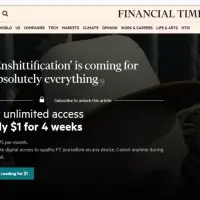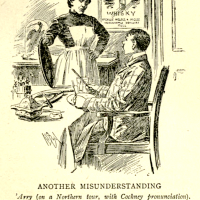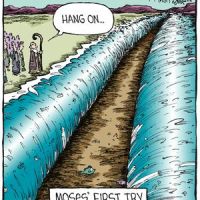 I am in my sixth year of teaching “The Fantasy and Science Fiction of C.S. Lewis” at The King’s College in New York City. I inherited this online course from Dr. Sørina Higgins, who followed the original mind behind the course, the late Dr. Bruce Edwards. After a year of working with their curriculum, I redeveloped the course to include a full series of lectures that anchor the online discussion and course projects.
I am in my sixth year of teaching “The Fantasy and Science Fiction of C.S. Lewis” at The King’s College in New York City. I inherited this online course from Dr. Sørina Higgins, who followed the original mind behind the course, the late Dr. Bruce Edwards. After a year of working with their curriculum, I redeveloped the course to include a full series of lectures that anchor the online discussion and course projects.
However you decide to teach it, “The Fantasy and Science Fiction of C.S. Lewis” will be a reading-intensive course. As my students are from diverse backgrounds and come from many disciplines in a Liberal Arts college, my lectures provide background material and close readings of the texts. I also leaned in on certain aspects. For example, my lectures on Narnia provide a survey of the critical reading tools that these non-lit students would normally get in an undergraduate program in English Literature. Many of these methods follow Lewis’ own approaches, such as pairing “Meditation in a Toolshed” with The Voyage of the “Dawn Treader”. I add in other elements, such as world-building in lectures like “Proposals for the Creation of Narnia,” “C.S. Lewis and the Epistolary Tradition,” and my work in reading The Screwtape Letters with the Dr. Ransom SciFi books in a single fictional universe, The Field of Arbol. I also provide fairly high-level theological analysis, including my work on Cruciformity and the Narrative Spiritual Theology of C.S. Lewis and lectures like “Remembering Heaven.”
I think it is a cool course—though no doubt challenging. Fortunately, King’s is a very cool school (e.g., see here and here), and the students have a strong ability to read deeply, think critically, and triangulate the course material with their individual intellectual, spiritual, cultural, and vocational development.

One of the factors that make this course challenging is the movement between different genres and periods of Lewis’ fiction. Narnia is different in many ways from the Science Fiction books or his WWII-era theological novellas, The Screwtape Letters and The Great Divorce. If you are not already a Lewis reader, a classic SciFi fan, or an avid reader of dystopias, That Hideous Strength can be a deeply puzzling book. And most students have never read anything like Till We Have Faces.
As some of the students were struggling with Out of the Silent Planet last week, one of them noted that reading it before Narnia might be helpful. It is certainly something that I have considered. I currently teach the course in four movements:
- The Chronicles of Narnia in Publication Order: The Lion, the Witch and the Wardrobe, Prince Caspian, The Voyage of the Dawn Treader, The Silver Chair, The Horse and His Boy, The Magician’s Nephew, The Last Battle
- Theological Novellas: The Screwtape Letters and The Great Divorce
- The Ransom Cycle: Out of the Silent Planet, Perelandra, That Hideous Strength, with a second look at The Screwtape Letters
- Mythopoeia: Till We Have Faces
As I was redesigning the course, I went back and forth on whether we should follow this pattern, or whether we should read Lewis chronologically (and I am a fan of that approach). Chronologically, it would look like this:
- WWII-era: Out of the Silent Planet, The Screwtape Letters, Perelandra, That Hideous Strength, The Great Divorce
- Early 1950s: Narnia, Till We Have Faces
The publication order of Narnia is pretty close to the order of writing and represents that period well for Lewis.
 For all the times I have hammered on about Reading Lewis Chronologically, my rationale for beginning with Narnia and turning to the theological novellas before the Science Fiction had a few factors.
For all the times I have hammered on about Reading Lewis Chronologically, my rationale for beginning with Narnia and turning to the theological novellas before the Science Fiction had a few factors.
 Primarily, I was concerned about a first-day confrontation with Lewis’ first work of popular fiction, Out of the Silent Planet. I have found that Silent Planet is a strange place to start for a generation like ours. Very few undergraduate students are already lovers of classic Science Fiction before its golden age. The SciFi novels we are reading today—and there is no shortage of great writers and voracious readers—are written more like epic fantasies (deeply implicated psychological journeys, complex world-building, etc.) than Lewis’ medieval-invoking, inversive, postcolonial, modernist/anti-modernist culture-cracking novel, Out of the Silent Planet. Finally, practically speaking, Out of the Silent Planet is harder to catch up on if a student begins the course late.
Primarily, I was concerned about a first-day confrontation with Lewis’ first work of popular fiction, Out of the Silent Planet. I have found that Silent Planet is a strange place to start for a generation like ours. Very few undergraduate students are already lovers of classic Science Fiction before its golden age. The SciFi novels we are reading today—and there is no shortage of great writers and voracious readers—are written more like epic fantasies (deeply implicated psychological journeys, complex world-building, etc.) than Lewis’ medieval-invoking, inversive, postcolonial, modernist/anti-modernist culture-cracking novel, Out of the Silent Planet. Finally, practically speaking, Out of the Silent Planet is harder to catch up on if a student begins the course late.
By contrast, about half of my students had Narnia read to them as children or encountered it in their school curriculum growing up. And almost all of my students watched the Disney interpretation of The Lion, the Witch and the Wardrobe as children. This will perhaps make some readers feel like they are aging quickly, but most of my first years were born the year the film was released. Very few students have absolutely no encounter with Narnia before they arrive in my class, and those that have missed Narnia usually sign up because of The Screwtape Letters or Mere Christianity. The Lion, the Witch and the Wardrobe is a great place to invite new students into an intensive literature course.
 Plus, well, Narnia is just super fun! It is rare for serious readers to read all seven books carefully and then go, “meh.” Something is there for everyone, whereas the Ransom Cycle takes more investment on the readers’ part to get started. Invariably, students also usually love one of the Ransom books— Out of the Silent Planet, Perelandra, That Hideous Strength, or The Screwtape Letters—even if they don’t love adult speculative fiction more generally. Beginning with Narnia invites readerly investment in fresh ways.
Plus, well, Narnia is just super fun! It is rare for serious readers to read all seven books carefully and then go, “meh.” Something is there for everyone, whereas the Ransom Cycle takes more investment on the readers’ part to get started. Invariably, students also usually love one of the Ransom books— Out of the Silent Planet, Perelandra, That Hideous Strength, or The Screwtape Letters—even if they don’t love adult speculative fiction more generally. Beginning with Narnia invites readerly investment in fresh ways.
 From a close-reading perspective, The Lion, the Witch and the Wardrobe is both a rich and accessible novel to teach. It invites reading in different modes and leaves a lot of space for students to talk about their own ideas without losing sight of the text. Students often have a passionate response to The Lion, the Witch and the Wardrobe (though not always a positive one). I have taught The Lion, the Witch and the Wardrobe for high school, undergraduate, graduate, and Senior’s College students. I have used the novel in classes about literary theory, theology, children’s literature, speculative fiction, C.S. Lewis’ life and work, “Communication, Leadership, and Culture,” and as an introduction to the Liberal Arts. I could honestly spend an entire term on Lewis’ first foray through the wardrobe. So I like beginning with The Lion, the Witch and the Wardrobe.
From a close-reading perspective, The Lion, the Witch and the Wardrobe is both a rich and accessible novel to teach. It invites reading in different modes and leaves a lot of space for students to talk about their own ideas without losing sight of the text. Students often have a passionate response to The Lion, the Witch and the Wardrobe (though not always a positive one). I have taught The Lion, the Witch and the Wardrobe for high school, undergraduate, graduate, and Senior’s College students. I have used the novel in classes about literary theory, theology, children’s literature, speculative fiction, C.S. Lewis’ life and work, “Communication, Leadership, and Culture,” and as an introduction to the Liberal Arts. I could honestly spend an entire term on Lewis’ first foray through the wardrobe. So I like beginning with The Lion, the Witch and the Wardrobe.
And we must admit that in the dozen or so years between Out of the Silent Planet on a wager and writing The Lion, the Witch and the Wardrobe, Lewis had grown as a writer.
Beyond the richness and approachability of Narnia, I like the four movements of my course. I love going from The Last Battle to The Great Divorce—two apocalyptic visions of the afterlife, and two incredibly strange books from a genre perspective. I like that the new Eden tale, Perelandra, is just a handful of books after Magician’s Nephew with its own fairy tale revisioning of Genesis. The Screwtape Letters and The Great Divorce pair really well together: they are both theological novellas published in a serial form in The Guardian, and they are mirror-image tales about the heart of temptation in each reader’s spiritual life. Knowing how war haunts Narnia allows Out of the Silent to be more prophetic: if you read that epilogue and closing letter of Out of the Silent, it sounds like WWII has begun; it is still 2 years away. The themes of war, leadership, and courage in Narnia and Out of the Silent helps makes sense of how WWII is a living reality in all of the Ransom Cycle books.
 Finally, the jump from Narnia to Till We Have Faces is quite startling for most students—even though it is only a few months of Lewis’ time between the last two Narnian chronicles and Till We Have Faces. Lewis’ myth retold is complex, literary, mythic, and intimate in a way that none of his other writing approaches. If Lewis’ genre fiction faded away in culture, I suspect that his least-read book, Till We Have Faces, might still be studied from time to time as literary fiction in universities.
Finally, the jump from Narnia to Till We Have Faces is quite startling for most students—even though it is only a few months of Lewis’ time between the last two Narnian chronicles and Till We Have Faces. Lewis’ myth retold is complex, literary, mythic, and intimate in a way that none of his other writing approaches. If Lewis’ genre fiction faded away in culture, I suspect that his least-read book, Till We Have Faces, might still be studied from time to time as literary fiction in universities.
There are some practical and personal reasons I chose the four movements rather than a chronological approach. Specifically, my four movements provide three “seams” in the curriculum that works well with King’s students’ needs for navigating their semester. Plus, Bruce Edwards designed the curriculum with a similar outline, and Sørina Higgins passed it on to me. I am inclined to trust their teacherly and literary wisdom.
Well, that’s the rationale. Is it wise? Have I made a case for these four movements for a Liberal Arts undergraduate program where most students are not literature majors, but all students have some training in theology, Biblical studies methods, and cultural criticism? Or have I fallen into some deep heresy in terms of Lewis’ works or curating an encounter with a diverse reading list?
I would love your thoughts in the comments below.
 I must admit, though, that even this reading- and writing-intensive course is leaving a lot out. I don’t teach The Pilgrim’s Regress, Letters to Malcolm, Lewis’ short stories, his narrative poems, or any of his incomplete fiction.
I must admit, though, that even this reading- and writing-intensive course is leaving a lot out. I don’t teach The Pilgrim’s Regress, Letters to Malcolm, Lewis’ short stories, his narrative poems, or any of his incomplete fiction.
And, tragically, I am leaving out most of C.S. Lewis’ linking essays or books that make the literature richer, e.g., The Allegory of Love as background to The Pilgrim’s Regress and Out of the Silent Planet; Screwtape in the context of The Problem of Pain and the early BBC talks; A Preface to Paradise Lost with Perelandra; the Abolition of Man lectures with That Hideous Strength; Lewis’ sermon “The Weight of Glory” with The Great Divorce, and so on. Any small set of pairings (like the Ransom Cycle, Narnia, theological novellas, a study of divine figures, a study of character transformation, Lewis’ classics retold, etc.) would provide excellent material for a full semester of study.
Plus, I don’t have time to address even the most immediate intertextual links, e.g. Bunyan’s Pilgrim’s Progress as background to The Pilgrim’s Regress; H.G. Wells’ First Men in the Moon and War of the Worlds behind Out of the Silent Planet (not to mention David Lindsay’s Voyage to Arcturus and Charles Williams’ The Place of the Lion). John Milton’s Paradise Lost with Perelandra; the entire catalogue of Inklings’ writings before 1944 with That Hideous Strength (or Lewis’ dystopia with Orwell’s 1984 on the topic of language and control); Dante’s Purgatori0 with The Great Divorce, and so on. Honestly, I would have no idea how to narrow down the intertextual elements in The Screwtape Letters, except to recommend Dante’s Comedy, Charles Williams’ Descent into Hell, Boswell’s Life of Johnson, everything G.K. Chesterton wrote, and the entire English epistolary tradition (both epistolary novels and certain famous collections of letters). Reading the books hidden in any one of Lewis’ novels would be an entire course of study, not a single class.
Not that this excuses my professorial sins if I have made the wrong choice. But it does illustrate how diverse and varied the bookshelf is that Lewis has bequeathed to us. At the very least, I hope it can inspire your own personal curriculum of reading Lewis. As I have always argued, rereading Lewis is always more important than reading Lewis in any particular order. Ultimately, my rationale is to introduce students to Lewis as an experimental storyteller who gives us the tools to open up the doors of our imaginations and see our world in brighter and bolder colours. This order seems to work.






















Thanks Brenton for your comprehensive review.
I’m impressed with what you do.
My understanding is that the CSL books that most demonstrate Barfieldian philosophy are >
Allegory of Love, That Hideous Strength, Allegory of Man, Till We Have Faces
… but I’m not aware that this has yet been explained / taught.
It is beginning to be explored for Tolkien for example in this new book:
‘Tolkien’s Hidden Pictures: Anthroposophy and the Enchantment in Middle Earth’ by Mark McGivern.
Thanks for the note, Owen! I have never read Lewis in particularly Barfieldian ways, but I see certain threads that run through all of Lewis’ writing. However, I think the most Barfieldian series in terms of language would be the Ransom Cycle: Out of the Silent Planet, The Screwtape Letters, Perelandra, and That Hideous Strength. I have been struggling to articulate the relationships … it will take me a while before I get it precise. But I think it is there.
And your work on the Owen Barfield site has helped me work through your Grandfather’s philosophy of language.
Lewis and Tolkien both understood and appreciated Barfield’s teaching of the “Ancient Semantic Unity of Language” … this they refer to and apply in their work.
Thoroughly enjoyed this discussion, as always. Also, happy to see you back.
Dr. Dickieson, I really enjoyed this post and am really pleased to see you bCK IN action
Thanks for these great notes, Ken! I am “back,” though still limping a bit. I’ll post on it in a bit.
I felt like a weaver could use your pairings for a tartan… a thicker thread here, a thinner but bright colored thread there… You always encourage us to wrap ourselves up in these books. I was very glad to see your post in my inbox! And I like you in the instagram photo – looking revitalized.
That’s sweet Lola! I am appreciative of the encouragement–and a metaphor I can keep rolling through my mind.
And yes, I’ve been hyping up on Instagram…. We’re in an unusual situation here. But it has been a lovely past couple of months of renewal for me.
I hope your writing is going well!
Glad to see you back, Brenton. Hope all is well.
Dana
Hi Dana, I appreciate the note. My imaginative capacities got a wee bit thin, I’m afraid. But I am recovering!
Thank you for putting this post together. I watched a couple of the videos. All is enjoyable!
Thanks for the nice note, Annette!
Thanks for this! Very interesting – there are probably lots of good approaches to reading more Lewis wherever one starts, but you make a good case for this one!
I’m not sure what Lewis fiction I read before Narnia – I think Screwtape, Divorce, and Silent Planet, Perelandra, and That Hideous Strength (though I’m not certain of the order, there, other than the last three in publication order…!) – with the ‘likely myth’ of the Fall in The Problem of Pain thrown in there somewhere.
I do like Narnia in publication order… and think it’s fun to think about Narnia as a sort of (however different) ‘crowning’ science-fiction sequel to the Ransom books (though in story-chronology ‘pre-quel’, overlap, and, I suppose, sequel, by turn).
I’ve thought about how much Tolkien’s Father Christmas Letters are analogous to Narnia in various ways, but more recently how Narnia is analogous to Middle-earth in other ways…
Yes, there are many connections that let the stories live even more. Michael Ward’s Planet Narnia helps us see the Ransom Cycle-Narnia links.
Yes, I really enjoyed that book – an excellent ‘recommended further reading’ selection for your students – and any- and everybody else interested in Lewis’s fiction, poetry, and thought and artistry!
Hi David, I think you’d like this Chesterton comment: https://apilgriminnarnia.com/2018/03/14/chesterton-arthur/#comment-141393
Pingback: The Office Hours Dialogues: What I Am Looking For in a Research Paper (Part 1) | A Pilgrim in Narnia